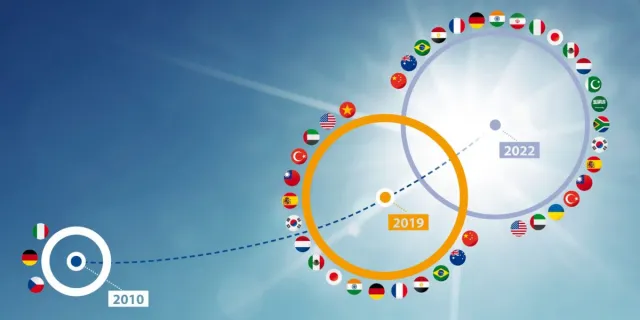Ukraine makes a bid for PV growth
Jul 26, 2019 03:03 PM ET
- The final segment in pv magazine’s look at unsung solar markets heads to Ukraine, where a generous feed in tariff and developments in the corporate PPA segment looks likely to push installations past the 1 GW mark for 2019.

The number of markets posting GW scale installation figures each year has grown from just three in 2010 to almost 20 in 2019.
Ukraine saw more than 700 MW of new PV installed in 2018, and in the first four months of 2019, the market commissioned more than 600 MW. If one counted installation figures from April 2018 to April 2019, the figure would go beyond the magic 1 GW mark. Much of this progress has been made possible through a very generous feed-in tariff scheme, remunerating ground-mount solar installations with a fixed rate of €0.1502/kWh until 2030.
Additionally, the conditions for power purchase agreements have improved considerably since 2017. “(They) stood the bankability test with many international lenders and private equity investors, and have been found acceptable for financing the renewable energy projects in Ukraine, including those undertaken by the EBRD, NEFCO, Natixis, Total Eren, Scatec Solar, AlGihaz and NBT,” writes Svitlana Teush, Head of Construction, Renewable Energy and Infrastructure, at Redcliffe Partners Law Firm.
On April 25, 2019, Ukraine amended Law No 2712-VIII On Amendments on Certain Laws of Ukraine on Ensuring Competitive Conditions for Electricity Production from Renewable Energy Sources. The change went into effect on May 22, 2019. Central to the new regulations are the changes to the feed-in tariff. Ukraine’s government had deemed the burden on electricity price development to be too high and adjusted the remuneration scheme. Ukraine has now decided to move towards an auctions system, starting from this year.
The government will determine a quota on a five-year term basis. The law prescribes minimum quotas for the capacity additions for various renewable energy sources. Solar, like wind, is assured a minimum of 15% of any renewable energy quota announcement. For the first batch of auctions from 2020 to 2022, the country has already set the minimum quota at 30%. New solar projects with capacities larger than 1 MW can then participate in the one-stage sealed-bid auctions. Winning bids will receive feed-in tariff support as high as their bids for periods of 20 years. The offtake of the generated electricity is guaranteed by the government. Per the new law, auctions will be held twice a year, from around April 1 and October 1, but starting this year on July 1.
“As with the producer under the FIT, the winner of an auction can obtain the local content bonus, namely a 5% increment to the auction price where the local content is at the level of 30%-50%, or a 10% increment where that content is higher. Local content is not mandatory,” Teush adds. Successful bidders must commission their photovoltaics systems within two years to be eligible for support, the law further stipulates. Also, to stimulate competition, the maximum quota offered to a single bidder cannot exceed 25% of the total annual quota of the respective year.
Also read


